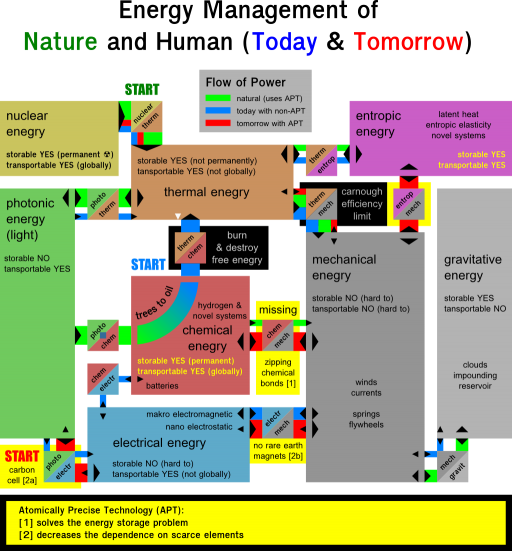Difference between revisions of "Energy conversion"
From apm
(→Related: cleanup and split-off of of == External Links ==) |
(→Nanoscale: molecular power converters: added a few new ones) |
||
| Line 17: | Line 17: | ||
AP technology provides several possibilities for energy conversion that work in a mill/zip/conveyor belt like style: | AP technology provides several possibilities for energy conversion that work in a mill/zip/conveyor belt like style: | ||
| − | * [[chemomechanical converters]] | + | * [[chemomechanical converters]] – the link for massive and efficient energy storage that is missing today (2021) |
| − | + | * [[electromechanical converters]] – two types? | |
* [[entropomechanical converters]] | * [[entropomechanical converters]] | ||
| − | * [[Diamondoid solar cell | + | ---- |
| + | * [[Diamondoid solar cell]]s – optoelectric/solarelectric converters | ||
| + | * [[Atomically precise electrochemical converters]] – basically batteries when there is atomically precise control over matter | ||
| + | ---- | ||
| + | * [[mechanoradio and radiomechanical conversion]] <br>– spinning electrical dipoles really fast mechanically <br>– the limit might be somewhere at 100GHz? (nanoscale [[levitation]] likely needed to limit friction at speeds close to the [[unsupported rotating ring speed limit]]) | ||
| + | * [[mechanooptical conversion]] – '''this is very new''' – exciting elecronic stated by force applying mechanic manipulation on bound molecules | ||
| + | * [[optomechanical conversion]] – '''basically photochemistry''' – causing a conformational change through electronic structure change through optical excitation | ||
| + | The [[teraherz gap]] between radio frequencies and far infrared frequencies | ||
| + | * is too high for generation by moving charges mechanically and also | ||
| + | * is challenging to cover even from the electronic side – ([[non mechanical technology path]]) | ||
== Mesoscale == | == Mesoscale == | ||
Revision as of 18:50, 14 June 2021
Atomically precise technology for energy conversion can:
- solve the enegry storage problem making renewable energy storable and fossile or nuclear fission baseload power plants unnecessary
- circumvent burning processes that unnecessarily devaluates energy
[Todo: add infographic]
Different power converters have heterogeneity residing on different size scales.
Contents
Nanoscale: molecular power converters
AP technology provides several possibilities for energy conversion that work in a mill/zip/conveyor belt like style:
- chemomechanical converters – the link for massive and efficient energy storage that is missing today (2021)
- electromechanical converters – two types?
- entropomechanical converters
- Diamondoid solar cells – optoelectric/solarelectric converters
- Atomically precise electrochemical converters – basically batteries when there is atomically precise control over matter
- mechanoradio and radiomechanical conversion
– spinning electrical dipoles really fast mechanically
– the limit might be somewhere at 100GHz? (nanoscale levitation likely needed to limit friction at speeds close to the unsupported rotating ring speed limit) - mechanooptical conversion – this is very new – exciting elecronic stated by force applying mechanic manipulation on bound molecules
- optomechanical conversion – basically photochemistry – causing a conformational change through electronic structure change through optical excitation
The teraherz gap between radio frequencies and far infrared frequencies
- is too high for generation by moving charges mechanically and also
- is challenging to cover even from the electronic side – (non mechanical technology path)
Mesoscale
thermomechanical:
diamondoid heat pump system
Used base technologies can be: microcapsules, infinitesimal bearings and thermal switching cells
Note that although the efficiency is limited by the Carnough-cycle the conversion can be near reversible.
Makroscale
thermonuclear
Complex macroscopic systems made from advanced diamondoid metamaterials may lead to significant improvements here.
Related
External links
- Wikipedia: transducer, actuators, ...
